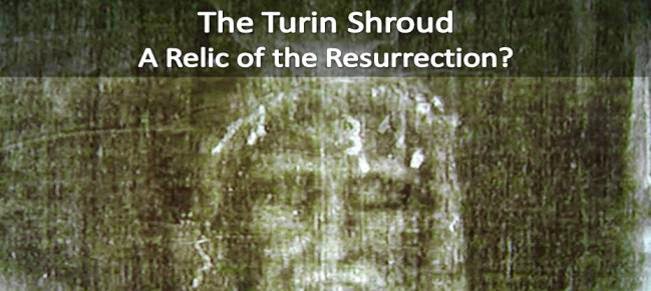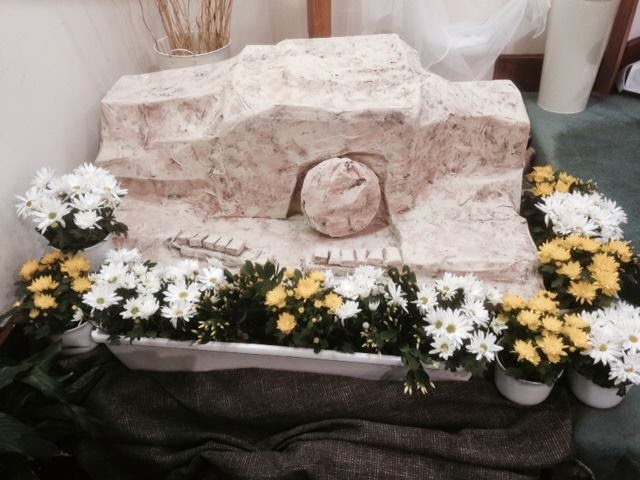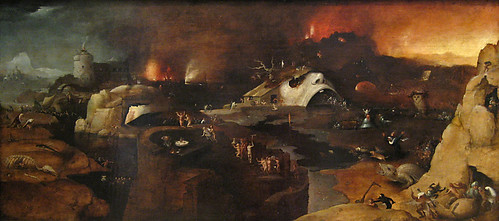A Word in Season - Augustin Press 2001
Night Office ...
OCTAVE OF: EASTER
TUESDAY Year
I
First Reading
1 Peter 1:22-23; 2:1-10
Responsory 1 Pt 2:5.9
Build yourselves like living stones into a spiritual house, a holy priesthood. + Offer spiritual sacrifices acceptable to God through Jesus Christ, alleluia.
V.
You are a chosen race, a royal priesthood, a holy nation, a people God has claimed as his Own. + Offer spiritual sacrifices ...
Second Reading From the writings of Aemiliana Lohr
(Dns Herrenjahr Band IT, 154-157
Our youth is renewed
Easter has made
Christ's resurrection a present reality for ourselves; we have risen with him.
Our life in Christ that began with our baptism has been renewed. Christ our God
has led us from death to life. No matter how long ago the day of our baptism,
time and space count for nothing in the sacred mystery. It has happened now; it
is now that we have put on the new being. That is the great joy of Easter: our
youth is renewed like the eagle's.
The baptized
are children; they remain children not in the sense of an infantile immaturity
but in the sense of a divine originality and simplicity. They have put on
Christ, and as he is essentially a son, their share in him has changed their
nature and made them the Father's children too. Nothing of the corrupting
complexity and sterile multifariousness of the world can remain in those who
have been regenerated through Christ and have risen again to divine youth.
Their thinking has become childlike in its Simplicity, because they stand with
God above the disunity of the world in a second, eternal childhood.
Christ said: Whoever will not accept
the kingdom of God like a child will never enter it.
This divine
childhood may, however, grow old and die unless it finds appropriate
nourishment. We hear a maternal warning in the Church's call to us: Like
newborn children, desire the pure milk
of the spirit. There is nothing feeble about the nourishment the Church our
mother offers her children. It is the heroic blood of her crucified
Bridegroom, the conqueror of death and hell, which makes us invincible too,
childlike and strong at one and the same time. It makes us strong, in fact,
because it makes us childlike. That is the nourishment which produces children
and conquerors, the food we must long for.
We already know
the nature of that divine food which is to nourish our new childhood. It is
Christ, the incarnate Word of the Father, the sacrifice of the new covenant,
dwelling in us through God's Holy Spirit. Christ is the milk on which the Church our mother rears her children, not to the
false maturity of the world but to the abiding and everlasting childhood of the
children of God. It is this holy and heavenly milk which Clement of Alexandria praises in the hymn at the end of
his book Teacher:
Jesus Christ, you are the heavenly milk
flowing eagerly from the gentle breast
of your gracious bride, your wisdom;
gather your children in simplicity
around you
so that in pure song, with innocent
tongue,
they may call you holy,
Christ, the leader of
youth.
The divine
simplicity which is fed on the Church's milk
is faith, that childlike power which makes us invincible and gives every
Christian dominion over the world. In the dying martyr, the barren virgin, and
the despised monk, faith achieves triumphs of life such as those who are sated
with the world's pleasures long for in vain. The victory that conquers the
world is faith.
And what is the
essence of this faith? Let us listen to Saint John: Who are the conquerors
of the world, if not those who believe that Jesus is the Son of God? Faith
in the redemption of the world by the incarnate Son of God, faith in his cross
and resurrection, faith in the Lord who lives on in his Church, faith in the
divine life that dwells in our own hearts - in a word, the faith of Easter was
and is the invincible strength of the Church and her children. The divine
simplicity of that faith solves every problem, overcomes every need, and
surrounds those who in the eyes of the world perish in disgrace with the glory
of an eternal resurrection in God.
Responsory
Rom 6:4.3
By our baptism we were buried
with Christ, we shared in his death,
+ so that as Christ was raised
from the dead by the glory of the Father, we too might live a new life, alleluia.
V. By being baptized into Christ
Jesus, we have all shared in his death, + so that as ...
Lohr, Aemiliana (1896-1972), born in
Dusseldorf, Germany,
studied literature and philosophy at the
University
of Cologne and taught before
entering the Benedictine monastery of
Herstelle in Germany in 1927. For several years she was chronicler and annalist,
but most of
her life was given to
writing. She was thoroughly familiar with the
works of Ildefonse
Schuster, Pius Parsch, and Odo Casei on the popular explanation of the liturgy. In her book, The Church's Year of Grace, her mind soars above historical and philological detail to
grasp the actual reality of each Mass. She is the author also of
The Great Week.
+++++++++++++++++
Saturday, April 7, 2012
An idea, "the
happiness of guilt" - Holy Saturday
The church has settled at the
grave to weep. She looks where
they have laid their Lord, where the woman has laid the Adam where it buried
the people where it has the man overthrown by his advice (see FIG. Peter
Chrysologus, Serm. 80). She sees
it and cries.
She weeps at the tomb of the
Lord, as the Lord at the tomb of Lazarus wept: the death of people over the
grave of life, about the sin that killed the author of life.
|
|
|
Jesus is laid in
the grave -
Stations of the Cross in the Church of St. Blaise, Glottertal
|
But her tears flow gently and
quietly. It is no longer the
painful lament of Sunday Septuagesima, they rocked. The death of Adam has lost its terror
at the tomb of Christ. The death
of obedience has deleted sin. No
longer crashes the "massa damnata" from sin to sin, from death to
death down, but the body of the obedient rests in hope. An idea of the "happiness of
guilt" that "such and so great a Redeemer was invented worth"
... makes the show end (the church and the soul) calm and hopeful.
¶ Aemiliana Löhr OSB: The
manor year. The mystery of Christ
in Ordinary of the Church . 2. Tape the fourth edition. Regensburg 1942. 63f. (Trs. from German)
https://search.yahoo.com/search?p=Aemiliana+L%C3%B6hr&fr=dss_yset_chr







